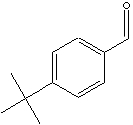PRODUCT IDENTIFICATION

H.S.CODE
CLASSIFICATION
PHYSICAL AND CHEMICAL PROPERTIES
130 C
0.97
NFPA RATINGS
AUTOIGNITION
REFRACTIVE INDEX
GENERAL DESCRIPTION & APPLICATIONS
APPEARANCE
98.5% min ( m Form 95% min )
|
|
|
| 4-tert-BUTYLBENZALDEHYDE | ||
|
PRODUCT IDENTIFICATION |
||
| CAS NO | 939-97-9 |
|
| EINECS NO. | 213-367-9 | |
| FORMULA | (CH3)3CC6H4CHO | |
| MOL WT. | 162.23 | |
|
H.S.CODE |
||
| TOXICITY | ||
| SYNONYMS | p-tert-Butylbenzaldehyde; TBBA; 4-(1,1-dimethylethyl)-benzaldehyde; | |
| PRICE |
|
|
|
CLASSIFICATION |
|
|
|
PHYSICAL AND CHEMICAL PROPERTIES |
||
| PHYSICAL STATE | clear to pale yellow liquid | |
| MELTING POINT |
| |
| BOILING POINT |
130 C | |
| SPECIFIC GRAVITY |
0.97 | |
| SOLUBILITY IN WATER |
| |
| pH | ||
| VAPOR DENSITY | ||
|
NFPA RATINGS |
||
|
AUTOIGNITION |
| |
|
REFRACTIVE INDEX |
1.5270 | |
| FLASH POINT |
| |
| STABILITY | Stable under ordinary conditions | |
|
GENERAL DESCRIPTION & APPLICATIONS |
||
| Benzaldehyde(also called Benzenecarbonal) is the simplest representative of the aromatic aldehydes. It is a colorless liquid aldehyde with a characteristic almond odor. It boils at 180°C, is soluble in ethanol, but is insoluble in water. Benzaldehyde is formed by partial oxidation of benzyl alcohol and readily oxidized to benzoic acid and is converted to addition products by hydrocyanic acid or sodium bisulfite. It is also prepared by oxidation of toluene or benzyl chloride or by treating benzal chloride with an alkali, e.g., sodium hydroxide. Benzaldehyde is the first step in the synthesis for fragrances. It undergoes simultaneous oxidation and reduction with alcoholic potassium hydroxide, giving potassium benzoate and benzyl alcohol. It is converted to benzoin with alcoholic potassium cyanide, with anhydrous sodium acetate and acetic anhydride, giving cinnamic acid. Benzaldehyde and its derivatives are used chiefly in the synthesis of other organic compounds, ranging from pharmaceuticals to plastic additives. They are important intermediate for the processing of perfume and flavouring compounds and in the preparation of certain aniline dyes. Compounds which do not have alpha-hydrogen atoms cannot form an enolate ion and do not undergo electrophilic alpha-substitution and aldol condensation. Aromatic aldehydes such as benzaldehyde and formaldehyde may undergo disproportionation in concentrated alkali (Cannizaro's reaction); one molecule of the aldehyde is reduced to the corresponding alcohol and another molecule is simultaneously oxidized to the salt of a carboxylic acid. The speed of the reaction depends on the substituents in the aromatic ring. Two different types of aldehydes (aromatic and aliphatic) can undergo crossing reaction to form fomaldehyde and aromatic alcohols. 4-tert-Butylbenzaldehyde is used in perfumery. It is used as an intermediate for pharmaceuticals and agrochemicals. | ||
| SALES SPECIFICATION | ||
|
APPEARANCE |
clear to pale yellow liquid | |
| PURITY |
98.5% min ( m Form 95% min ) | |
| SPECIFIC GRAVITY | 0.960 - 0.980 at 20 C | |
| TRANSPORTATION | ||
| PACKING | 200kgs in drum | |
| HAZARD CLASS | ||
| UN NO. | ||
| OTHER INFORMATION | ||
|
|
||
|
|
|